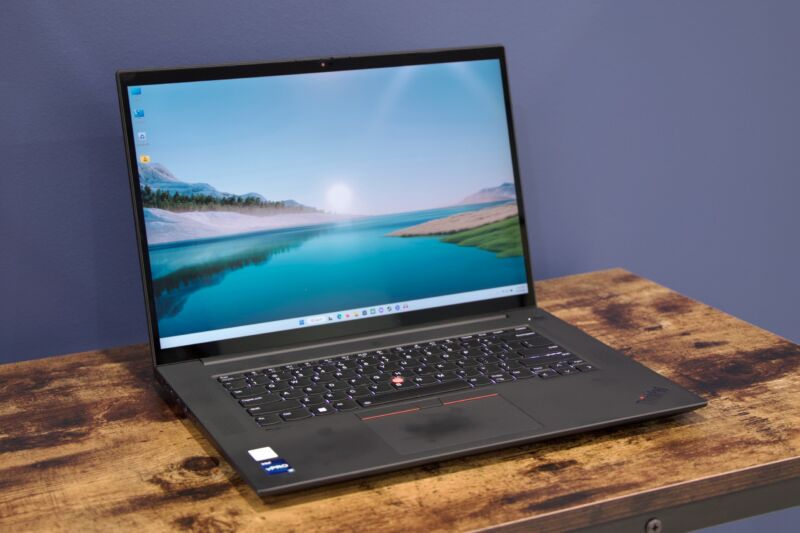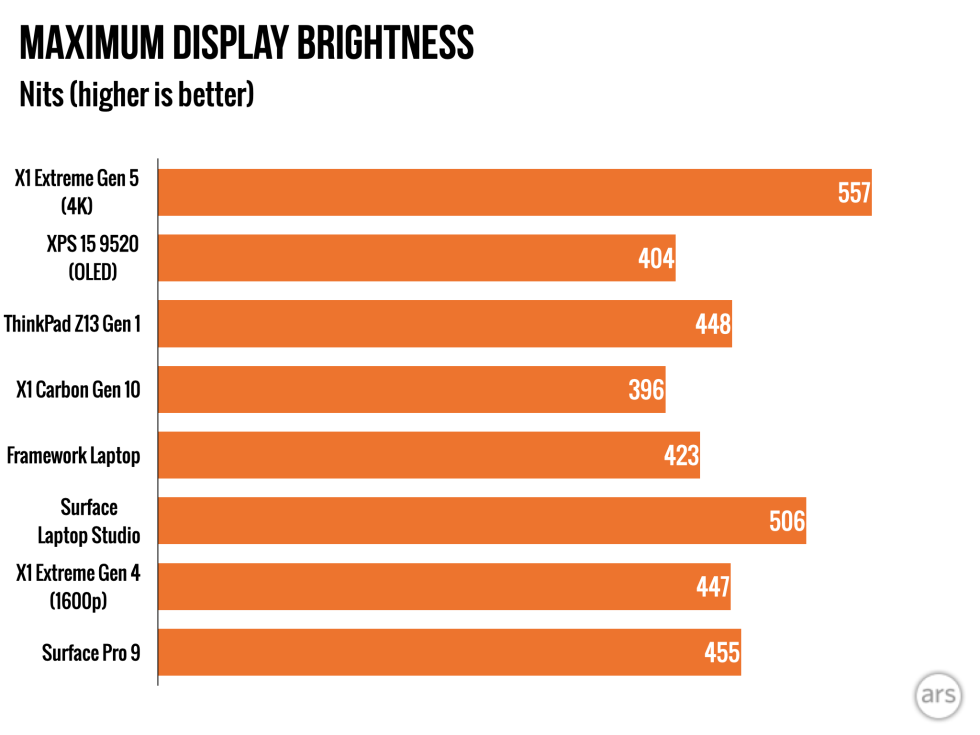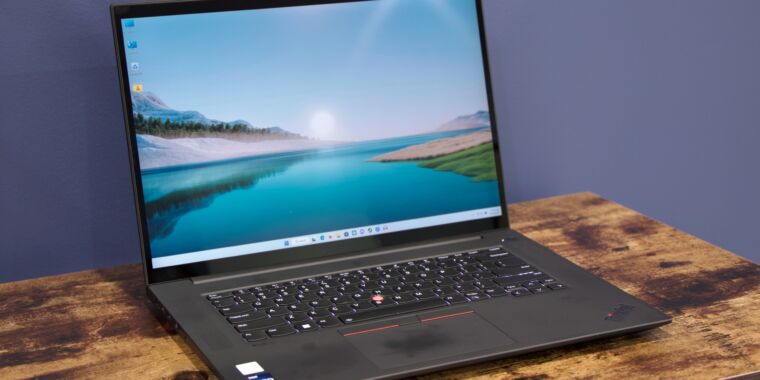
Andrew Cunningham
| Specs at a glance: Lenovo ThinkPad X1 Extreme Gen 5 (As reviewed) | |
|---|---|
| Display | 16-inch 3840×2400 IPS touchscreen (283 PPI) |
| OS | Windows 11 Pro |
| CPU | Intel Core i7-12800H (six P-cores, eight E-cores) |
| RAM | 16GB 4,800 MHz DDR5 (2 DIMMs) |
| GPU | Nvidia GeForce RTX 3070 Ti (8GB, 100 W), Intel Iris Xe |
| Storage | 1TB NVMe SSD |
| Networking | Wi-Fi 6E (802.11ax), Bluetooth 5.3 |
| Battery | 90 WHr |
| Ports | 2x Thunderbolt 4, 2x 5Gbps USB-A, SD card reader, HDMI 2.1, headphones |
| Size | 13.57×9.06×0.17 inches (344.7×230.1×18.0 mm) |
| Weight | Starts at 4.14 pounds (1.88kg) |
| Warranty | 1 year |
| Price as reviewed | $3,280 from Lenovo |
Our take on the fifth-generation version of Lenovo’s ThinkPad X1 Extreme is—spoiler—pretty much the same as what we said about the fourth-generation version. It runs hot and it’s expensive, but it’s powerful and arguably a better choice than Dell’s XPS 15 for people whose laptop is their primary computer rather than a sidecar for a desktop workstation or gaming PC, thanks to an expanded port selection and more powerful GPU options.
It also changes even less than is typical for a year-over-year laptop refresh, adding Intel’s 12th-generation Alder Lake CPUs but sticking to the same RTX 3000-series GPUs from Nvidia and similar memory and storage configurations. We’ll point you to last year’s review for extended commentary on the keyboard, ports, and general look and feel, which haven’t changed much year to year. It uses the typical comfortable Lenovo laptop keyboard plus the pointing nub and trackpad, all among the best you can get in a laptop from Lenovo, Dell, Apple, or any other company.
The X1 Extreme is also reasonably easy to upgrade and repair compared to thinner and lighter laptops, with easily accessible DDR5 RAM slots and a pair of M.2 SSD slots. In our review model, one had a 1TB SSD in it, and the other was open for upgrades. Lenovo still publishes a hardware maintenance manual (PDF) to help people perform those and other upgrades and repairs.
We were given a version with a different screen and GPU than the one we got last year, which gives us a better idea of how the high-end configurations will perform but less of a sense of year-over-year battery life changes or other improvements (the move from 11th- to 12th-gen Intel CPUs has been bad for battery life overall, though laptops like the ThinkPad that use H-series chips have managed to break even or improve slightly).
-
Like most ThinkPads, this keyboard and trackpad are among the best you can find in any laptop. But the textured black surface is a fingerprint magnet, and it’s hard to totally clean even if you’re trying to make it look nice for pictures.
Andrew Cunningham -
The power button-mounted fingerprint sensor.
Andrew Cunningham -
Webcam security cover.
Andrew Cunningham -
Ports on the left: Power, two Thunderbolt 4 ports (which won’t trickle-charge the laptop—you use the included proprietary adapter or you don’t charge), HDMI 2.1, and a headphone jack.
Andrew Cunningham -
Two 5Gbps USB-A ports, whatever those are called these days, plus an SD card reader.
Andrew Cunningham
One change worth noting compared to last year’s X1 Extreme: Lenovo offers different configuration options for its 16-inch screen. There’s a new 1920×1200 display on the base model, down from the 2560×1600 display that was the low-end option last generation. If you do spring for the 2560×1600 screen, though, you get an appreciable refresh rate upgrade, from the typical 60 Hz all the way up to 165 Hz. You should generally stick to 60 Hz most of the time for the sake of battery life, but higher refresh rates can make animations and scrolling look smoother and make games feel more fluid and responsive—it’s worth looking into if you think you’ll be playing games on the X1 Extreme regularly.

Andrew Cunningham
The top-end options are 4K IPS screens, one with touch and one without (unlike the XPS 15, there’s no OLED option available). We tested the top-end 3840×2400 IPS touchscreen; the panel is bright and sharp, with a respectable 1,397:1 contrast ratio and a 557 nit peak brightness (as measured by our colorimeter). But its color gamut coverage is somewhat disappointing for something this expensive, with 98.3 percent coverage of the sRGB gamut (which is fine) and 85.1 percent coverage of the DCI-P3 gamut (which is a bit low). Apple’s MacBook Pros and Dell’s OLED screen for the XPS 15 cover all of the DCI-P3 gamut, and while it’s not a must-have feature for everyone, Lenovo is falling short of its competition here.








